Rehabilitation Program: Verbal And Visual Memory
Click to try FREE for 15-Days.
This module contains exercises which train simultaneously verbal and visual memory (menus in a restaurant or cities in a trip).
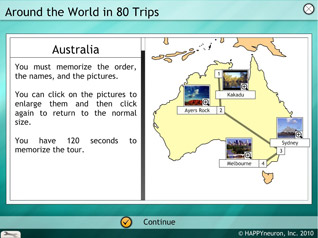
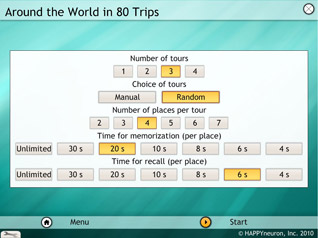
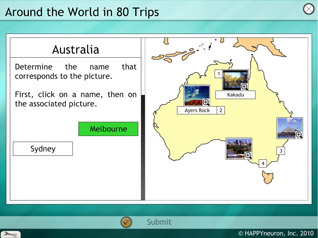
Around the World in 80 Trips
The task
In this exercise the subject embarks on a splendid tour through the most beautiful regions on earth. The exercise consists of memorizing the itineraries of tours that may be selected from a list of destinations. The patient must keep in mind the names of the places he visits, the images associated with those places, and the order of the landmarks visited. He has to recall those elements on a grid afterwards.
What it trains
This task trains the patient's visual and spatial memory pertaining to environmental information. He has to visualize pictures and written names (visual information), locate the pictures in space (spatial information) and then build a spatial relationship among the pictures. He will thus train his visual and spatial orientation and his perception skills. These are the skills that enable us to mentally manipulate and rotate information in space by taking different perspectives.
Parameters
A very high degree of control is available. The parameters that can be selected are the number of countries (1, 2, 3, or 4), the choice of countries (manual or random), the number of tours in each country (2, 3, 4, 5, 6, or 7), the memorization time per tour (unlimited, 30, 20, 10, 8, 6, or 4 seconds), the recall time per tour (unlimited, 30, 20, 10, 8, 6, or 4 seconds), and the presence or not of a distraction task.
Number of Unique Configurations
Over 2,300 unique game configurations and significant data set depth.


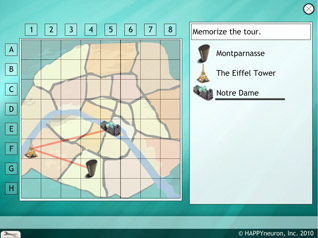
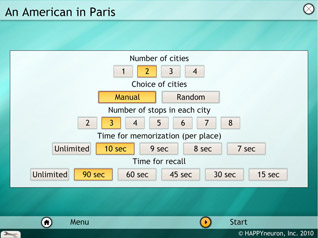
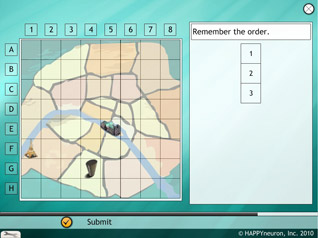
An American in Paris
The task
Time to get the guidebooks out because this game provides a splendid tour through eight of the greatest cities on earth, including Paris, Rome and London! This exercise is divided into two parts. In the first part, the patient has to memorize the names of famous monuments of a given city (Paris, Rome, London…), together with their location on a grid. He must also pay attention to the presented itinerary. In the second part, the monuments on the grid have to be replaced and the itinerary shown in the first part has to be reconstructed.
What it trains
This task trains the user's visual spatial perception as he has to form a mental image of the grid with all the information it contains. It also trains his visual spatial memory. Indeed, he has to store the mental images he has created in his mind in order to memorize the information and recall them effectively. In daily life, good visual-spatial skills are needed to orient oneself in a neighborhood, to retrace one's steps through a crowd, to remember landmarks, and also to be able to recognize that a person is in an unfamiliar environment.
Parameters
A very high degree of control is available. The parameters that can be selected are the number of cities (1, 2, 3, or 4), the choice of cities (manual or random), the number of stops (2, 3, 4, 5, 6, 7, or 8), the memorization time per stop (unlimited, 10, 9, 8, 7, 6, 5, 4, or 3 seconds), the information recall time (unlimited, 10, 9, 8, 7, 6, 5, 4, or 3 seconds) and the presence or not of a distraction task.
Number of Unique Configurations
Over 1,600 unique game configurations and significant data set depth.



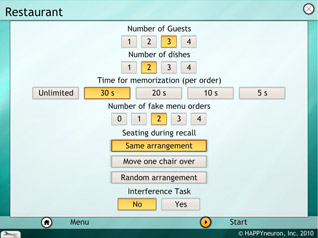
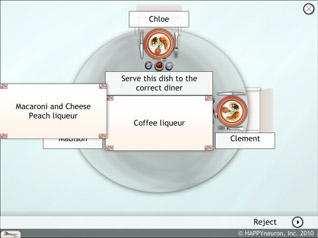
Restaurant
The task
Waiters in restaurants have the amazing ability to memorize all individual orders and to serve them all to the right people. In this exercise, the patient has to memorize the dishes associated with the names of different people. He must then recall the dishes and memorize who the dishes are associated with. The place of some people can change at the recall stage.
What it trains
This task trains the subject's verbal and visual memory. Indeed, he has to both memorize the orders of each person and remember the position of each of them around the table, knowing that this position may change. It therefore also trains his ability to mentally rotate the scene he has kept in his mind.
Parameters
The parameters that can be selected are the number of guests (1, 2, 3, or 4), the number of dishes (1, 2, 3, or 4), the time for memorization per order (unlimited, 30,20,10, or 5 seconds), the number of fake menu orders (0, 1, 2, 3, or 4), the seating during recall (same arrangement, move one chair on, or random arrangement) and the presence of an interference task (yes or no).
Number of Unique Configurations
Over 2,200 unique game configurations and significant data set depth.


Click to try FREE for 15-Days.
